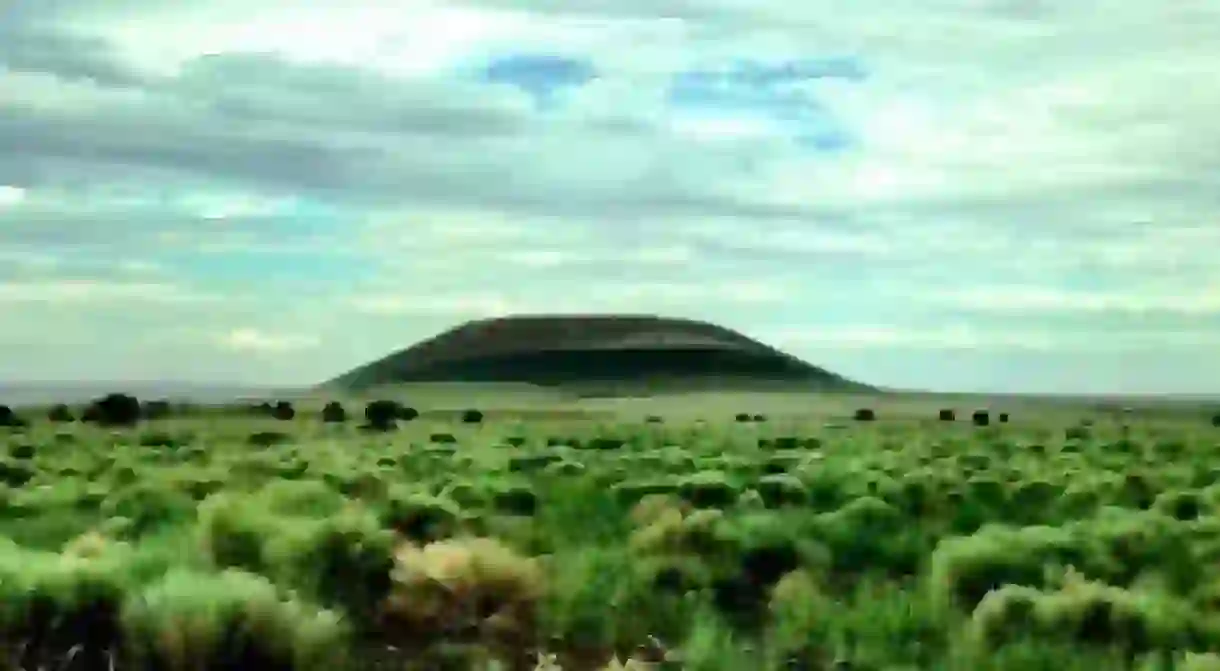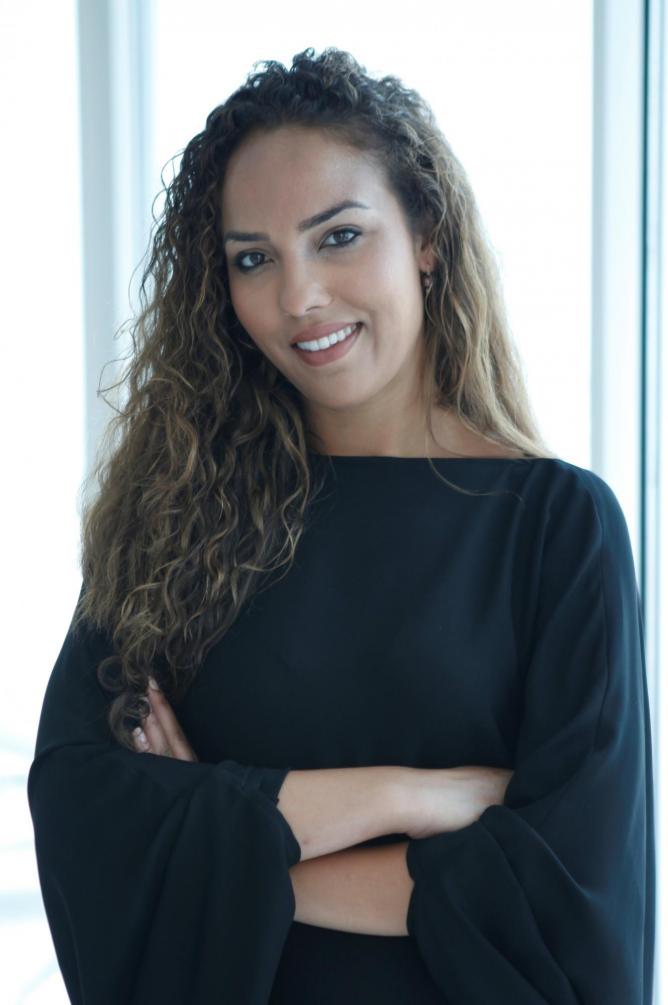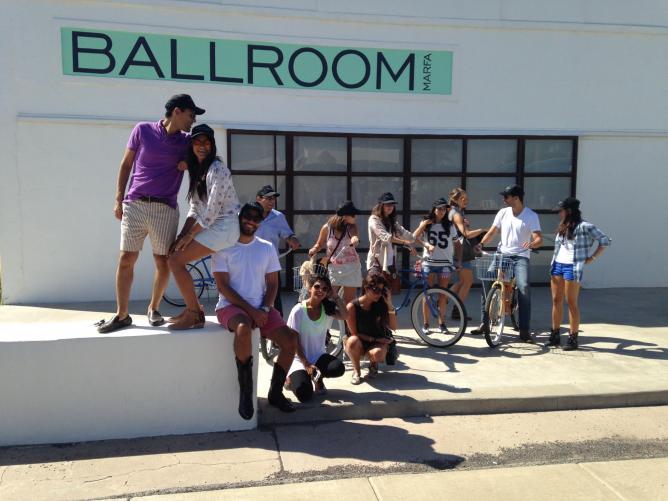An Interview with Alia Al-Senussi - Building Bridges to the Arts

Princess Alia Al-Senussi is a descendant of Libyan royalty who has lived and studied all over the world. After working with artists Emilia and Ilya Kabakov in Egypt, she developed a love for the art world and has never looked back.
Now based in London, Al-Senussi works to promote the arts and serves on the boards and committees at institutions like the Tate, Serpentine, Guggenheim, ICA London, Parasol Unit and Art Dubai. We spoke to her about Middle Eastern art, how to build bridges to the art world and her favorite exhibitions from around the globe.

We know that your interest in the arts began in earnest when you were working with Russian artists Emilia and Ilya Kabakov in Egypt. What was it about this experience that triggered your passion for the art world?
My experience working with the celebrated artists Emilia and Ilya Kabakov in Siwa, Egypt, this crazy romantic ethereal desert oasis (possibly home to Alexander the Great’s lost army and Cleopatra’s healing waters), was the beginning of my love affair with artists, art and the art world. Emilia, along with her husband, Ilya, were the first artists I worked with, on my very first week on the job in the arts (in fact the week after I handed in my Master’s dissertation!) as a project coordinator for the Siwa Project organized by the Albion Gallery, a non-profit project that brings renowned international artists to Siwa, Egypt, to interact with the local population and make ephemeral work that is more about creating an experience than creating an object.
Here they created their first ever ‘Ship of Tolerance’ (showed in Sharjah during the Biennale in 2010 along with other stops around the world), which was at the time the Ship of Siwa in 2005. So that was how I discovered my passion for art and the art world, purely by chance, because it spoke to the local community and the group of art patrons and collectors that were able to experience it. I had never worked in the arts but as I had an interest for non-governmental organisations working in the Middle East I thought this would be an adventure and marry my interests in diplomacy and community work with the ability to work and witness first-hand change in the cultural landscape.
Also, the fact that Siwa bordered Libya was particularly poignant as at that point I had never been able to visit the country of my heritage (I have since been, following the revolution during the Arab Spring). In the end, it was fate and I fell in love with art, the art world and everything about it.

Does your Libyan heritage play a role in how you perceive or appreciate art?
I want to assist the organisations I work closely with in understanding the intricacies of the Middle East, and hopefully Libya in particular, and bring my experiences to bear in decisions relating to projects that are the nexus of art, culture and heritage. For example the Global Heritage Fund does fantastic work because of the dedication of its staff and board members and I’m excited to be a part of that, hopefully finding creative ways to bridge the gaps of contemporary art and heritage.
Libya has not yet fully participated in this Middle Eastern art boom. I would love to be able to be the one to build that bridge. My focus in Libya is heritage and education. I want to help in Libya’s development but also help Libya understand that its history is something to be valued, respected and preserved. While recent history is a period most people want to forget, ancient Libyan history should be a source of pride—Libya has incredible sites like Sabrata, Leptis Magna and Cyrene.
I work towards the goal, and in the hope that despite this troubling time, when Libya prospers and grows, the government will recognize the importance of these sites, as a possible boon to the tourism industry but also as a source of economic diversification and patriotic reconciliation. I’ve had an international upbringing and I value that, and I love to see the same incorporated in to an artist’s work and see artists who value their own heritage, life experiences and societies but who also understand the role they play in the wider world. For example, the American installation artist Theaster Gates, who works to better his own neighbourhood in Chicago also creates art that speaks to his community and the rest of the world.
I like to demystify the art world to people who aren’t involved because it can be intimidating. Art and design does not have to be a passion, does not have to be all-encompassing. Art and design is an important cultural marker—it defines who we are, be it as a culture, as a place or as a society and I truly believe everyone should value and support artistic production in whatever way they are able.

The term ‘Middle Eastern art’ seems to be used by many as a marker of a uniform or congruous phenomenon. Can Middle Eastern artists be said to share a set of traits?
Middle Eastern artists share a set of traits in so far as Middle Eastern people in general do—there are of course commonalities in culture, language, and shared experiences. However, this diverges in people just as it does in art. I am passionate about contemporary art and supporting living artists.
I focus mostly on Middle Eastern art and artists as this is close to my heart and my heritage, but I think it important to not just pigeonhole one self culturally or ethnically. Art provides an alternative discourse by which we can solve problems, promote heritage and instill national pride. My hope has been that by educating artists and patrons we can then educate the wider population on the benefits that art can bring to their everyday lives, not only beautifying the communities where one lives but also promoting more creative ways to solve problems, bridge differences and build community sentiment and strength.
What common misconceptions about Middle Eastern art do you find frustrating? How has Middle Eastern art evolved in recent years?
Living artists interpret our living history. I believe they are the oracles of our time and represent modernity, the good and the bad. People often criticize Middle Eastern artists as being obsessed with politics, and to this, I say, of course they are! In the way that artists throughout history have responded to the moment in time in which they live, so are the artists living in the Middle East, or in the Diaspora, through revolutions, occupation, disasters and war.
One of my favourite talks I’ve seen was Glenn Lowry, the Director of MoMA giving the keynote address in Art Dubai’s second year, telling the audience that MoMA was a museum for the city of New York, and that each city and society needed to think of what their cultural institutions should be for them rather than what can be imported. These institutions are important to help educate local artists too, exposing them to artists from different eras as well as countries. The Middle Eastern art market is still very much a niche market, having evolved only over the last ten years. The international community finds it a fascinating view on to Middle Eastern culture (in the widest sense) and it provides a way in which these individuals can interact outside more fraught venues.
That being said there is still a dearth of institutions in the region itself so interest by the Western world in the Middle East provides opportunities for artists from the region to show their work to their own community as well as the international world. ‘Here and Elsewhere’ recently opened at the New Museum and is one of the most comprehensive surveys I’ve ever seen at identity and the coming together of intellectual discourse and political activism in the arts.
The success of Art Dubai is pivotal in all aspects of the Middle Eastern art market—bringing together collectors, patrons, artists and curators from all over the region with each other and also with the incredible mix of the premier figures in the international art world. The Guggenheim and Louvre will also define how artists and non-governmental agencies participate in the development of art and culture.
What role do women play in the evolution and promotion of Middle Eastern art?
Women have been pillars of the Middle Eastern arts scene, in each and every country and each and every part of the evolution of arts and culture in the Middle East, there is no doubt that women have been an engine for growth and education.

Most are aware of what’s happening arts-wise in Qatar or the UAE. Is there a Middle Eastern city or country perhaps less on the radar that people should visit to see contemporary art?
Saudi Arabia has a vibrant cultural scene and the Kingdom is emerging as a vital component of the Middle Eastern arts community. Private patrons, such as those that formed the Saudi Art Council, there fill the void as there are no government institutions yet to speak of, directly addressing their local communities.
You’ve used the term ‘creative business’ in the past. How does this term relate to your vision of an ideal contemporary art world?
The art world is a nexus of so many different academic and professional backgrounds that it is only logical that a business develops from it. Of course galleries are a business, but creative business is and can be so much more such as companies tailored to bringing technology to the art world like ArtBinder. Creative business provides a new avenue for development for the next generation of entrepreneurs and a boost to a battered economy, and possibly a way to level the playing field between the new world and the old.
For example, the Middle East has a burgeoning youth population and has a vastly different attitude to government support of people’s every day lives—for the most part they are rentier societies or welfare states using revenues from natural resources to support various elements of their citizens’ lives. I would argue that while Western governments continue to cut funding we are already seeing the debilitating effects of this on education and the lack of resources available to lower-income students, so much so that in the Middle East they should finally understand that this is the moment to create these programs and institutions—there is no time like now with so much political turmoil to bring people together through the arts and create new economies through creativity—and the youth of the Middle East are the perfect place to start as a part of this project.
You hold a number of board and committee positions with art institutions around the world, from the Global Heritage Fund to the Tate, and from the Guggenheim to Art Dubai. Do you represent the same vision with each of these organizations?
I not only work with artists, brands and galleries but I also serve on a variety of boards and committees with institutions such as the Tate, Serpentine, Guggenheim, ICA London, Parasol Unit and Art Dubai and my goal has always been to promote a shared understanding of the world as well as to educate a new generation of art enthusiasts, in the Middle East in particular, on the benefits of philanthropy and patronage. My role in each organisation is manifested differently and I work hard to tailor my participation to the various needs of each and every one.
The Tate holds a very special place in my heart. It was one of the first institutions I got involved with in London, through the Young Patrons. Shortly after the Middle East and North African Acquisitions Committee was launching and I was one of the first people on board. One thing led to another and I was asked to be a Young Patrons Ambassador then the Chair of the Young Patrons, and also to represent the Young Patrons on the board of the Tate. I have a responsibility to help it evolve and grow, not just in London, but in the Middle East also, and my fellow members of the Acquisitions Committee in particular feel this way also. My work, for instance, with the ICA London ranges from my activities as a Co-Chair of their annual gala to being an adviser to the Director, Gregor Muir, and executing a variety of projects such as ‘Cinema on the Steps: A focus on Middle Eastern Film’ and the upcoming ICA Off-Site at Duddell’s with a show titled ‘Hong Kongese’ which I will be curating with Gregor Muir and Abdullah Alturki. The ICA has been at the forefront of the arts in London, serving as a key component in artist’s development—integral to pushing boundaries and forcing us all to reflect on what it means to be contemporary—and is now going through a renaissance under the watchful and dynamic eye of Gregor Muir.
I am one of the original members of the Board of Patrons and the Advisory Board of Art Dubai, offering help when and where I can and acting as a cheerleader for all the incredible things that happen in the region and at the fair, which is a powerful platform for art and culture. I very much hope I see the day when more artists of Middle Eastern origin are integrated in to the wider art world. Art Dubai plays a big role in this, by being one of the main thoroughfares for artists, museum directors, patrons and collectors from the Middle East as well as elsewhere.

Before you started collaborating with non-profit arts organizations, you spent some time working in commercial art. In your opinion, what could these two different environments learn from each other?
There is always a sense of wariness between the commercial and non-commercial worlds. But of course there must be a symbiosis because truly one cannot exist without the other. I hope that commercial galleries take a more inclusive approach to the new enthusiasts flowing in to the art world and that the non-profits continue to understand their duties as key forums for education and evolution.
I work with Art Basel now and I see it as bridging my engagement with both worlds and also as a way to translate and interpret the commercial art experience for my friends who are just beginning their life in the art world. It is thrilling to help new collectors find their passion, particularly when gallerists and dealers do not yet know them, and even in many cases have not worked with any Middle Easterners. I love seeing the beginning of this journey and being a small part of it.
As a patron of the arts, you’ve no doubt attended numerous shows and exhibitions. Which of these was the most memorable over the last few years?
I’ll stick to the institutional shows for this question as if we included commercial galleries this list would be too overwhelming!
Marlene Dumas at the Stedelijk
Malevich at the Tate Modern
Conflict, Time, Photography at the Tate Modern (the first time I have literally had tears in my eyes leaving a show—the perfect marriage of my interest in politics, the ‘real’ world and art and really cemented my desire to complete my PhD in this subject)
James Turrell at LACMA
Here and Elsewhere at New Museum
Crystal Bridges Museum was a revelation, and a special stop on yet another road trip I took, this time it was more about American Civil Rights and music than art.
My entire #marfaroadtrip experience where we visited Marfa, Roden Crater, Santa Fe and toured the Southwest of the USA. Not far behind was a recent trip to Prospect New Orleans (a fascinating activation of the city—where I felt a deep connection to what they were trying to do, somehow drawing similarities to the happenings in the Middle East) and Dallas for 2×2 where I was awe-struck by the incredible institutions in Dallas and Fort Worth and generosity and enthusiasm of the local community.

What contemporary Middle Eastern novels and/or feature films would you recommend to our readers?
The Yacoubian Building by Alaa Al Aswany is an insightful assessment of Cairene culture. It was my first choice for a book club my friends and I organized years ago.
As for film, really any of the old Egyptian films from the 1960s and 1970s and even 1980s with the classic actors like Hossein Fahmy, Faten Hamama, and of course the crossover success of Omar Sharif. A nostalgic and wonderful show encapsulating this moment in cinema and Arabic culture is ‘Whose Gaze it Anyway?’ . The Egyptian dialect of Arabic became the universal Arabic partly because of the incredible movies created in this Golden Age of Cinema.
Which contemporary Middle Eastern artists would you recommend our readers find out more about?
Too many to enumerate here, but a good way to find them is to look through the Sharjah Biennial’s featured artists, the New Museum show ‘Here and Elsewhere’ as mentioned above and most significantly, the artists whom the Tate has collected with funds from the Middle East and North African Acquisitions committee such as Saloua Raouda Choucair, Yto Barrada, Ahmad Soudani, Ibrahim El Salahi, and so many more.
A visit to Art Dubai is also a necessary way to learn about what is happening with art in the region—but of course a look through the fair catalogue is helpful if a flight can’t be found.













